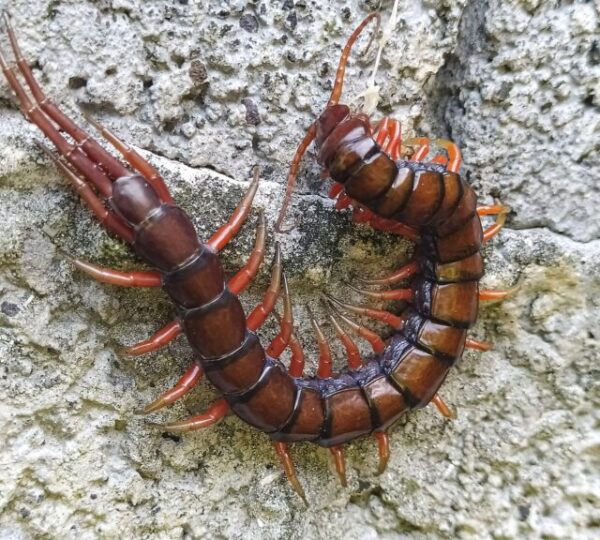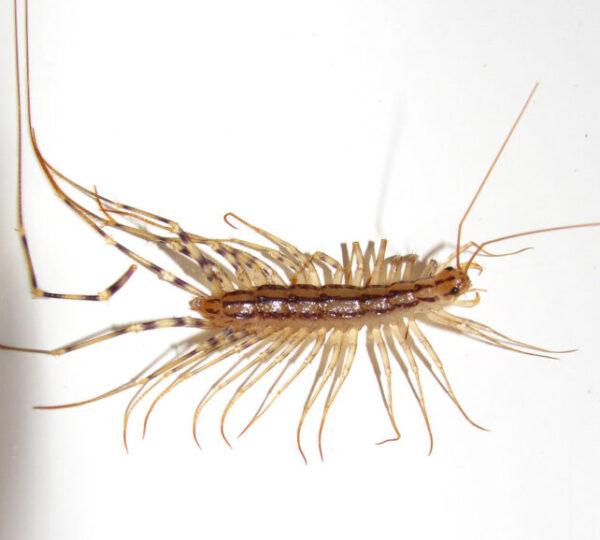Centipedes are among the most fascinating yet often misunderstood creatures that can enter human homes.
Easily recognizable by their elongated, segmented bodies, multiple pairs of legs, and long, sensitive antennae, centipedes have evolved over hundreds of millions of years to become one of nature’s most efficient predators.
Their coloration varies from pale yellow to dark brown, allowing them to blend seamlessly into their environments, whether that be under leaf litter outdoors or in the corners of a basement.
Centipedes also possess small but effective mouths equipped with venom glands, which they use to immobilize prey.
While this venom is potent for insects and other small animals, it rarely causes serious harm to humans. A bite may result in minor redness, soreness, or irritation, but medical emergencies from centipede bites are extremely rare.
The Anatomy of Centipedes
Centipedes are most famous for their numerous legs. Depending on the species, they can have anywhere from fifteen to seventy-seven pairs of legs.
These legs are not just for locomotion; they are highly adapted for climbing, running, and capturing prey.
Their segmented bodies, coupled with their waxy exoskeletons, allow them to twist, turn, and maneuver in ways that many other invertebrates cannot.
Despite their intimidating appearance, most centipedes are shy and will avoid human contact whenever possible.
Their sensory antennae are equally remarkable. These long, hair-like structures detect vibrations, chemical signals, and humidity changes, allowing centipedes to navigate dark or cluttered environments with precision.
This sensitivity is why centipedes are often found in damp areas of homes, such as basements, bathrooms, and under sinks, where they hunt other small insects and arthropods.
Fascinating Facts About Centipedes
Here are some little-known but true facts about centipedes that reveal just how extraordinary these creatures are:
Leg Count Increases With Age: Centipedes grow more legs as they age because they molt repeatedly throughout their lives. During each molt, they can regenerate lost or damaged legs.
It may take multiple molts for a centipede to fully restore its mobility if legs were lost, meaning older, more mature centipedes often have more legs than younger ones.
Ancient Origins: Centipedes are one of the oldest known land-dwelling animals, with fossils dating back over 400 million years.
They predate dinosaurs and many other modern animals, highlighting their incredible adaptability and evolutionary success.
Impressive Speed: Despite their elongated, segmented bodies, centipedes can move at astonishing speeds. When hunting or escaping a predator, they can cover more than a foot of floor in less than a second.
Their agility makes them efficient predators and also difficult targets for birds, rodents, or other animals that may prey on them.
Voracious Predators: Centipedes feed on a wide variety of prey, from insects like roaches and silverfish to earthworms and slugs.
Larger species may even hunt frogs, spiders, or small rodents, demonstrating their role as apex invertebrate predators in many ecosystems.
Their predatory behavior helps control pest populations naturally, which is one reason why they can be beneficial in human dwellings.
Long Lifespan: Certain species, including house centipedes, can live for up to six years, while larger centipedes in the wild may survive even longer.
This longevity allows them multiple reproductive cycles and contributes to maintaining balanced populations in their habitats.

Chilopoda Latreille, 1817
Centipedes in Your Home
Many people find centipedes unsettling when they appear in homes, often in bathrooms, basements, or crawl spaces.
While their presence can be alarming, it’s important to recognize that centipedes serve an ecological purpose inside the home.
They hunt common household pests such as cockroaches, spiders, silverfish, and ants. Unlike spiders, centipedes do not spin webs or build nests, meaning they rarely cause structural or aesthetic damage.
In moderation, having a few centipedes around can actually help reduce infestations of other more troublesome pests.
However, caution is warranted. A single centipede is one thing, but a full colony may indicate underlying issues, such as excessive moisture, a large pest population, or hidden entry points in your home.
Overpopulation can lead to increased encounters with humans and pets, and while centipedes are beneficial predators, they are not a replacement for professional pest control measures.
Natural Predators of Centipedes
Centipedes are part of a complex food web. Various species of birds, mice, frogs, beetles, and spiders prey upon them.
Larger centipedes, in turn, can prey on a range of smaller animals, including spiders and young frogs. In nature, predation helps maintain balanced populations, preventing any one species from overwhelming the ecosystem.
In homes, however, natural predators are typically absent, which means that centipede populations can increase unchecked if conditions are favorable.

Why You Should Never Kill a House Centipede
It might be tempting to squash a centipede when you see one scurrying across the floor. However, killing them is often counterproductive.
Centipedes are highly effective at controlling other pests naturally, meaning removing them could allow more harmful insects like cockroaches to thrive.
Additionally, centipedes are solitary and do not reproduce rapidly in domestic settings, so a few individuals do not generally constitute a real threat.
That said, proactive management is important. Centipedes can live up to ten years under the right conditions, so ignoring a larger infestation could result in years of repeated encounters.
The presence of centipedes may also indicate hidden environmental factors that need addressing, such as leaks, poor drainage, or high humidity.
Professional Pest Control and Management
For homeowners experiencing centipede activity, professional pest control is often the safest and most effective approach.
Experts can assess the situation, identify entry points, and determine if the centipedes are symptomatic of a larger pest problem.
Effective pest control typically includes moisture management, sealing cracks and crevices, and reducing populations of other insects that serve as food sources.
Even when centipedes have not become a major nuisance, preventive measures can ensure that they do not multiply or attract other unwanted pests.
Properly managed, the presence of a few centipedes can be tolerated and even beneficial, creating a natural form of pest control without the need for excessive chemical intervention.
Final Thoughts
Centipedes may be creepy at first glance, but they are fascinating, ancient, and ecologically valuable creatures.
Their role as natural predators, coupled with their unique biology and ancient lineage, makes them more friend than foe in most circumstances.
While a large population may require professional intervention, homeowners should consider the benefits these animals provide before resorting to killing them.
In conclusion, centipedes are not just harmless household visitors—they are sophisticated predators with an important role in both natural and domestic ecosystems.
By learning about their biology, habits, and benefits, homeowners can coexist with these creatures while maintaining a safe, pest-free environment.
With proper understanding and professional guidance when necessary, it is possible to appreciate centipedes for their ecological contributions rather than fear them as mere household pests.
Centipedes are among the most fascinating yet often misunderstood creatures that can enter human homes.
Easily recognizable by their elongated, segmented bodies, multiple pairs of legs, and long, sensitive antennae, centipedes have evolved over hundreds of millions of years to become one of nature’s most efficient predators.
Their coloration varies from pale yellow to dark brown, allowing them to blend seamlessly into their environments, whether that be under leaf litter outdoors or in the corners of a basement.
Centipedes also possess small but effective mouths equipped with venom glands, which they use to immobilize prey.
While this venom is potent for insects and other small animals, it rarely causes serious harm to humans. A bite may result in minor redness, soreness, or irritation, but medical emergencies from centipede bites are extremely rare.
The Anatomy of Centipedes
Centipedes are most famous for their numerous legs. Depending on the species, they can have anywhere from fifteen to seventy-seven pairs of legs.
These legs are not just for locomotion; they are highly adapted for climbing, running, and capturing prey.
Their segmented bodies, coupled with their waxy exoskeletons, allow them to twist, turn, and maneuver in ways that many other invertebrates cannot.
Despite their intimidating appearance, most centipedes are shy and will avoid human contact whenever possible.
Their sensory antennae are equally remarkable. These long, hair-like structures detect vibrations, chemical signals, and humidity changes, allowing centipedes to navigate dark or cluttered environments with precision.
This sensitivity is why centipedes are often found in damp areas of homes, such as basements, bathrooms, and under sinks, where they hunt other small insects and arthropods.
Fascinating Facts About Centipedes
Here are some little-known but true facts about centipedes that reveal just how extraordinary these creatures are:
Leg Count Increases With Age: Centipedes grow more legs as they age because they molt repeatedly throughout their lives. During each molt, they can regenerate lost or damaged legs.
It may take multiple molts for a centipede to fully restore its mobility if legs were lost, meaning older, more mature centipedes often have more legs than younger ones.
Ancient Origins: Centipedes are one of the oldest known land-dwelling animals, with fossils dating back over 400 million years.
They predate dinosaurs and many other modern animals, highlighting their incredible adaptability and evolutionary success.
Impressive Speed: Despite their elongated, segmented bodies, centipedes can move at astonishing speeds. When hunting or escaping a predator, they can cover more than a foot of floor in less than a second.
Their agility makes them efficient predators and also difficult targets for birds, rodents, or other animals that may prey on them.
Voracious Predators: Centipedes feed on a wide variety of prey, from insects like roaches and silverfish to earthworms and slugs.
Larger species may even hunt frogs, spiders, or small rodents, demonstrating their role as apex invertebrate predators in many ecosystems.
Their predatory behavior helps control pest populations naturally, which is one reason why they can be beneficial in human dwellings.
Long Lifespan: Certain species, including house centipedes, can live for up to six years, while larger centipedes in the wild may survive even longer.
This longevity allows them multiple reproductive cycles and contributes to maintaining balanced populations in their habitats.

Chilopoda Latreille, 1817
Centipedes in Your Home
Many people find centipedes unsettling when they appear in homes, often in bathrooms, basements, or crawl spaces.
While their presence can be alarming, it’s important to recognize that centipedes serve an ecological purpose inside the home.
They hunt common household pests such as cockroaches, spiders, silverfish, and ants. Unlike spiders, centipedes do not spin webs or build nests, meaning they rarely cause structural or aesthetic damage.
In moderation, having a few centipedes around can actually help reduce infestations of other more troublesome pests.
However, caution is warranted. A single centipede is one thing, but a full colony may indicate underlying issues, such as excessive moisture, a large pest population, or hidden entry points in your home.
Overpopulation can lead to increased encounters with humans and pets, and while centipedes are beneficial predators, they are not a replacement for professional pest control measures.
Natural Predators of Centipedes
Centipedes are part of a complex food web. Various species of birds, mice, frogs, beetles, and spiders prey upon them.
Larger centipedes, in turn, can prey on a range of smaller animals, including spiders and young frogs. In nature, predation helps maintain balanced populations, preventing any one species from overwhelming the ecosystem.
In homes, however, natural predators are typically absent, which means that centipede populations can increase unchecked if conditions are favorable.

Why You Should Never Kill a House Centipede
It might be tempting to squash a centipede when you see one scurrying across the floor. However, killing them is often counterproductive.
Centipedes are highly effective at controlling other pests naturally, meaning removing them could allow more harmful insects like cockroaches to thrive.
Additionally, centipedes are solitary and do not reproduce rapidly in domestic settings, so a few individuals do not generally constitute a real threat.
That said, proactive management is important. Centipedes can live up to ten years under the right conditions, so ignoring a larger infestation could result in years of repeated encounters.
The presence of centipedes may also indicate hidden environmental factors that need addressing, such as leaks, poor drainage, or high humidity.
Professional Pest Control and Management
For homeowners experiencing centipede activity, professional pest control is often the safest and most effective approach.
Experts can assess the situation, identify entry points, and determine if the centipedes are symptomatic of a larger pest problem.
Effective pest control typically includes moisture management, sealing cracks and crevices, and reducing populations of other insects that serve as food sources.
Even when centipedes have not become a major nuisance, preventive measures can ensure that they do not multiply or attract other unwanted pests.
Properly managed, the presence of a few centipedes can be tolerated and even beneficial, creating a natural form of pest control without the need for excessive chemical intervention.
Final Thoughts
Centipedes may be creepy at first glance, but they are fascinating, ancient, and ecologically valuable creatures.
Their role as natural predators, coupled with their unique biology and ancient lineage, makes them more friend than foe in most circumstances.
While a large population may require professional intervention, homeowners should consider the benefits these animals provide before resorting to killing them.
In conclusion, centipedes are not just harmless household visitors—they are sophisticated predators with an important role in both natural and domestic ecosystems.
By learning about their biology, habits, and benefits, homeowners can coexist with these creatures while maintaining a safe, pest-free environment.
With proper understanding and professional guidance when necessary, it is possible to appreciate centipedes for their ecological contributions rather than fear them as mere household pests.





